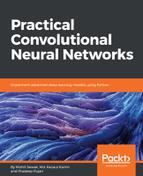As mentioned in the previous chapter, one of the main disadvantages observed during the training of large neural networks is overfitting, that is, generating very good approximations for the training data but emitting noise for the zones between single points. There are a couple of ways to reduce or even prevent this issue, such as dropout, early stop, and limiting the number of parameters.
In the case of overfitting, the model is specifically adjusted to the training dataset, so it will not be used for generalization. Therefore, although it performs well on the training set, its performance on the test dataset and subsequent tests is poor because it lacks the generalization property:

The main advantage of this method is that it avoids holding all the neurons in a layer to optimize their weights synchronously. This adaptation made in random groups prevents all the neurons from converging to the same goals, thus de-correlating the adapted weights. A second property found in the dropout application is that the activation of the hidden units becomes sparse, which is also a desirable characteristic.
In the preceding figure, we have a representation of an original fully connected multilayer neural network and the associated network with the dropout linked. As a result, approximately half of the input was zeroed (this example was chosen to show that probabilities will not always give the expected four zeroes). One factor that could have surprised you is the scale factor applied to the non-dropped elements.
This technique is used to maintain the same network, and restore it to the original architecture when training, using dropout_keep_prob as 1. A major drawback of using dropout is that it does not have the same benefits for convolutional layers, where the neurons are not fully connected. To address this issue, there are a few techniques can be applied, such as DropConnect and stochastic pooling:
- DropConnect is similar to dropout as it introduces dynamic sparsity within the model, but it differs in that the sparsity is on the weights, rather than the output vectors of a layer. The thing is that a fully connected layer with DropConnect becomes a sparsely connected layer in which the connections are chosen at random during the training stage.
- In stochastic pooling, the conventional deterministic pooling operations are replaced with a stochastic procedure, where the activation within each pooling region is picked randomly according to a multinomial distribution, given by the activities within the pooling region. The approach is hyperparameter free and can be combined with other regularization approaches, such as dropout and data augmentation.
Secondly, one of the simplest methods to prevent overfitting of a network is to simply stop the training before overfitting gets a chance to occur. This comes with the disadvantage that the learning process is halted. Thirdly, limiting the number of parameters is sometimes helpful and helps avoid overfitting. When it comes to CNN training, the filter size also affects the number of parameters. Thus, limiting this type of parameter restricts the predictive power of the network directly, reducing the complexity of the function that it can perform on the data, and that limits the amount of overfitting.
